4.2 通用橡胶-NR-SBR-BR-电子课件——【高分子材料 精】
- 格式:pptx
- 大小:2.33 MB
- 文档页数:5
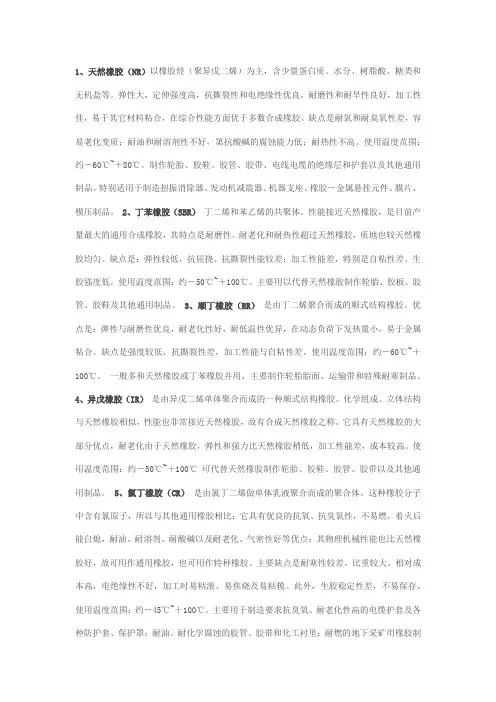
1、天然橡胶(NR)以橡胶烃(聚异戊二烯)为主,含少量蛋白质、水分、树脂酸、糖类和无机盐等。
弹性大,定伸强度高,抗撕裂性和电绝缘性优良,耐磨性和耐旱性良好,加工性佳,易于其它材料粘合,在综合性能方面优于多数合成橡胶。
缺点是耐氧和耐臭氧性差,容易老化变质;耐油和耐溶剂性不好,第抗酸碱的腐蚀能力低;耐热性不高。
使用温度范围:约-60℃~+80℃。
制作轮胎、胶鞋、胶管、胶带、电线电缆的绝缘层和护套以及其他通用制品。
特别适用于制造扭振消除器、发动机减震器、机器支座、橡胶-金属悬挂元件、膜片、模压制品。
2、丁苯橡胶(SBR)丁二烯和苯乙烯的共聚体。
性能接近天然橡胶,是目前产量最大的通用合成橡胶,其特点是耐磨性、耐老化和耐热性超过天然橡胶,质地也较天然橡胶均匀。
缺点是:弹性较低,抗屈挠、抗撕裂性能较差;加工性能差,特别是自粘性差、生胶强度低。
使用温度范围:约-50℃~+100℃。
主要用以代替天然橡胶制作轮胎、胶板、胶管、胶鞋及其他通用制品。
3、顺丁橡胶(BR)是由丁二烯聚合而成的顺式结构橡胶。
优点是:弹性与耐磨性优良,耐老化性好,耐低温性优异,在动态负荷下发热量小,易于金属粘合。
缺点是强度较低,抗撕裂性差,加工性能与自粘性差。
使用温度范围:约-60℃~+100℃。
一般多和天然橡胶或丁苯橡胶并用,主要制作轮胎胎面、运输带和特殊耐寒制品。
4、异戊橡胶(IR)是由异戊二烯单体聚合而成的一种顺式结构橡胶。
化学组成、立体结构与天然橡胶相似,性能也非常接近天然橡胶,故有合成天然橡胶之称。
它具有天然橡胶的大部分优点,耐老化由于天然橡胶,弹性和强力比天然橡胶稍低,加工性能差,成本较高。
使用温度范围:约-50℃~+100℃ 可代替天然橡胶制作轮胎、胶鞋、胶管、胶带以及其他通用制品。
5、氯丁橡胶(CR)是由氯丁二烯做单体乳液聚合而成的聚合体。
这种橡胶分子中含有氯原子,所以与其他通用橡胶相比:它具有优良的抗氧、抗臭氧性,不易燃,着火后能自熄,耐油、耐溶剂、耐酸碱以及耐老化、气密性好等优点;其物理机械性能也比天然橡胶好,故可用作通用橡胶,也可用作特种橡胶。
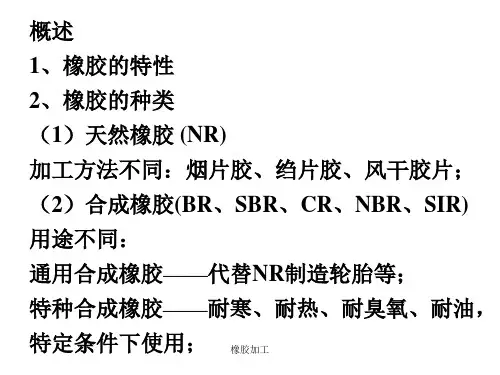
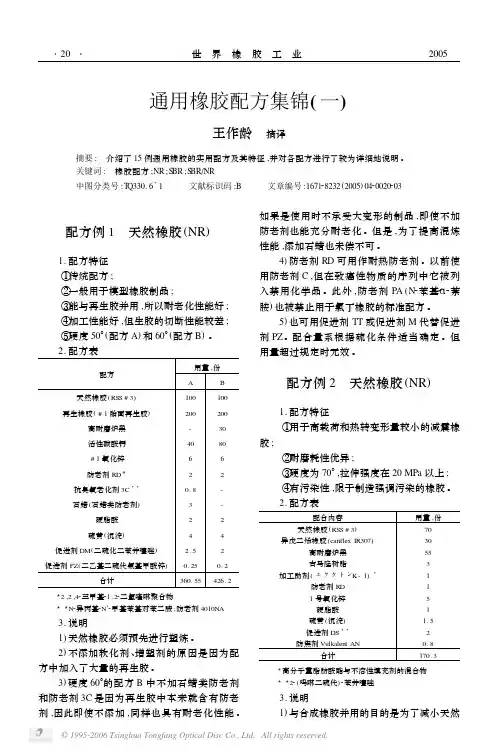
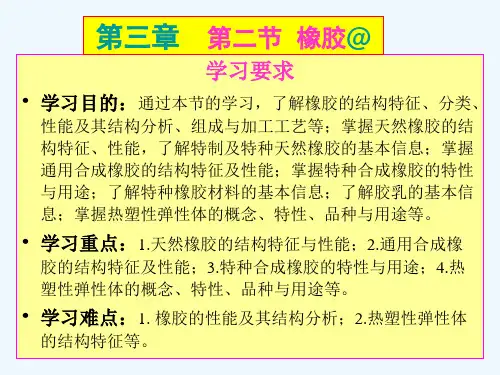
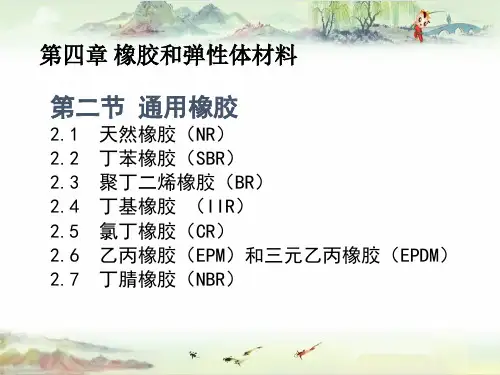
![NR、IR、BR、SBR、NBR、EPDM分别是什么橡胶[指南]](https://uimg.taocdn.com/d8ce4b791fb91a37f111f18583d049649b660ef0.webp)
NR、IR、BR、SBR、NBR、EPDM分别是什么橡胶1、天然橡胶(NR)以橡胶烃(聚异戊二烯)为主,含少量蛋白质、水分、树脂酸、糖类和无机盐等。
弹性大,定伸强度高,抗撕裂性和电绝缘性优良,耐磨性和耐旱性良好,加工性佳,易于其它材料粘合,在综合性能方面优于多数合成橡胶。
缺点是耐氧和耐臭氧性差,容易老化变质;耐油和耐溶剂性不好,第抗酸碱的腐蚀能力低;耐热性不高。
使用温度范围:约-60℃~+80℃。
制作轮胎、胶鞋、胶管、胶带、电线电缆的绝缘层和护套以及其他通用制品。
特别适用于制造扭振消除器、发动机减震器、机器支座、橡胶-金属悬挂元件、膜片、模压制品。
2、丁苯橡胶(SBR)丁二烯和苯乙烯的共聚体。
性能接近天然橡胶,是目前产量最大的通用合成橡胶,其特点是耐磨性、耐老化和耐热性超过天然橡胶,质地也较天然橡胶均匀。
缺点是:弹性较低,抗屈挠、抗撕裂性能较差;加工性能差,特别是自粘性差、生胶强度低。
使用温度范围:约-50℃~+100℃。
主要用以代替天然橡胶制作轮胎、胶板、胶管、胶鞋及其他通用制品。
3、顺丁橡胶(BR)是由丁二烯聚合而成的顺式结构橡胶。
优点是:弹性与耐磨性优良,耐老化性好,耐低温性优异,在动态负荷下发热量小,易于金属粘合。
缺点是强度较低,抗撕裂性差,加工性能与自粘性差。
使用温度范围:约-60℃~+100℃。
一般多和天然橡胶或丁苯橡胶并用,主要制作轮胎胎面、运输带和特殊耐寒制品。
4、异戊橡胶(IR)是由异戊二烯单体聚合而成的一种顺式结构橡胶。
化学组成、立体结构与天然橡胶相似,性能也非常接近天然橡胶,故有合成天然橡胶之称。
它具有天然橡胶的大部分优点,耐老化由于天然橡胶,弹性和强力比天然橡胶稍低,加工性能差,成本较高。
使用温度范围:约-50℃~+100℃ 可代替天然橡胶制作轮胎、胶鞋、胶管、胶带以及其他通用制品。
5、氯丁橡胶(CR)是由氯丁二烯做单体乳液聚合而成的聚合体。
这种橡胶分子中含有氯原子,所以与其他通用橡胶相比:它具有优良的抗氧、抗臭氧性,不易燃,着火后能自熄,耐油、耐溶剂、耐酸碱以及耐老化、气密性好等优点;其物理机械性能也比天然橡胶好,故可用作通用橡胶,也可用作特种橡胶。
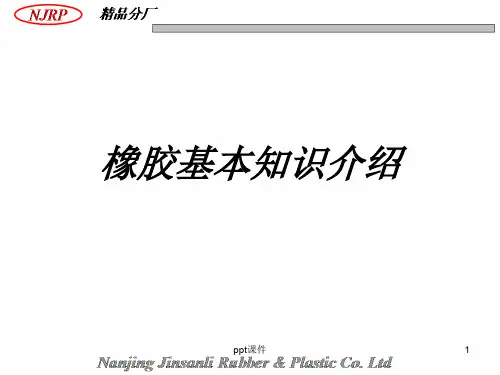
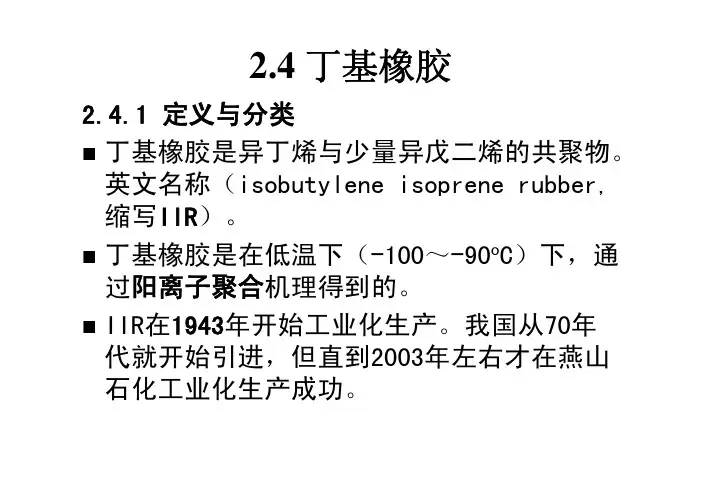
2.4 丁基橡胶2.4.1 定义与分类丁基橡胶是异丁烯与少量异戊二烯的共聚物。
英文名称(isobutylene isoprene rubber, 缩写IIR)。
丁基橡胶是在低温下(-100~-90o C)下,通过阳离子聚合机理得到的。
IIR在1943年开始工业化生产。
我国从70年代就开始引进,但直到2003年左右才在燕山石化工业化生产成功。
3.异丁烯主链上多而密集的侧甲基,填补了分子链间的孔隙——IIR耐透气性和耐透水性优异。
4.异丁烯主链上多而密集的侧甲基,导致分子链在相对运动时,内摩擦大、内耗高——适合用于阻尼减震材料。
5. IIR的自黏性和互黏性差,与其它通用橡胶相容性低——通过卤化的方法提高黏结性(卤素含量1~2%)。
内胎垫带无内胎轮胎的气密层:要提高该层与轮胎其它部件的粘合,使用的是卤化丁基橡胶。
医用橡胶塞防水卷材利用IIR的高耐热性——耐热运输带;利用IIR的高阻尼性——减震、吸振制品。
2.5.3 CR的性能特点(重点)结晶性橡胶——纯胶强度高,交联纯胶的强度略高于交联纯NR。
弹性低、动态内耗大、耐寒性差。
含有大量—Cl取代基团——阻燃性、耐烷烃油好、黏和强度高、但电绝缘性差。
C-Cl和C=C的共扼——耐热性、耐候性和耐O性优异,但低于IIR和EPDM。
32.5.4 CR的主要应用CR主要应用于阻燃、耐油、耐天候制品和黏合剂。
耐热、阻燃运输带。
耐油、耐化学腐蚀的胶管。
电线、电缆的外层胶。
门窗密封条。
公路路面添缝材料、桥梁支座的橡胶垫。
2.6 乙丙橡胶 定义与品种结构(重点)性能(重点)应用<一> 定义和品种乙丙橡胶是乙烯与丙烯在齐格勒—纳塔型催化剂催化下的无规共聚物。
根据是否加入第三种双烯类共聚单体分为:二元乙丙橡胶(英文ethylene-propylene-monomer, 缩写EPM)和三元乙丙橡胶(英文ethylene-propylene-diene-monomer,缩写EPDM)。
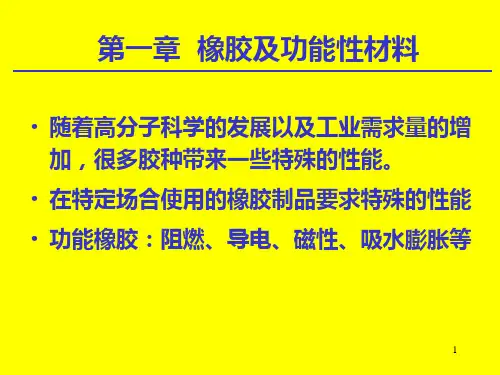
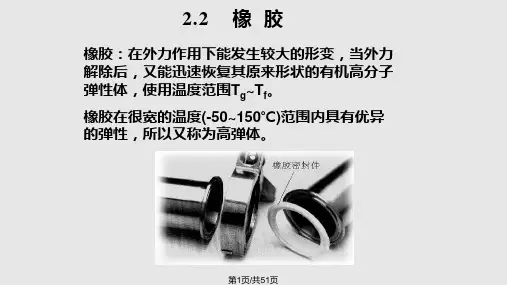
![高分子材料课件-4[1].2_通用橡胶共32页文档](https://uimg.taocdn.com/956934546529647d26285244.webp)
NR、IR、BR、SBR、NBR、EPDM分别是什么橡胶1, natural rubber (NR) to rubber hydrocarbon (polyisoprene) based, containing a small amount of protein, water, resin acids, sugars and inorganic salts. The utility model has the advantages of large elasticity, high extension strength, high tear resistance and electrical insulation, good abrasion resistance and drought resistance, good processability, easy adhesion to other materials, and superior performance in synthetic rubber in comprehensive performance. The disadvantage is that oxygen and ozone resistance is poor, easy aging, metamorphism, oil and solvent resistance is not good, the first corrosion resistance of acid and base is low, heat resistance is not high. Temperature range: about 60 DEG C ~80. Make tires, rubber shoes, hose, tape, wire and cable insulation and sheath, and other general products. The utility model is especially suitable for making torsional vibration eliminator, engine shock absorber, machine support, rubber metal suspension element, diaphragm and molded product.2, butadiene styrene rubber (SBR), butadiene and styrene copolymer. Performance is close to natural rubber, is the largest yield of general-purpose synthetic rubber, characterized by wear resistance, aging resistance and heat resistance, more than natural rubber, texture is more natural rubber uniform. Disadvantages are: low elasticity, anti bending, anti tear performance is poor; the processing performance is poor, especially the poor, low strength self adhesive rubber. Temperature range: about 50 DEG C ~100. Mainly used instead of natural rubber to make tires, rubber sheets, hose, rubber shoes and other general products.3, butadiene rubber (BR) is a cis structure by polymerization of butadiene rubber. The utility model has the advantages of good elasticity and wear resistance, good aging resistance, excellent low-temperature resistance, small heat generation under dynamic load and easy metal bonding. The disadvantage is low strength, poor tearing resistance, poor processability and self adhesion. Temperature range: about 60 DEG C ~100. Usually used in combination with natural rubber or styrene butadiene rubber. It mainly produces tyres, tread, conveyor belts and special cold resistant products.4, isoprene rubber (IR) is a kind of CIS structure rubber which is polymerized from isoprene monomer. The chemical composition and solid structure are similar to those of natural rubber, and the properties are very close to natural rubber. Therefore, synthetic rubber is called. It has most of the advantages of natural rubber, anti-aging, because of natural rubber, elasticity and strength than natural rubber slightly lower, poor processing performance, higher cost. Temperature range: about 50 DEG C ~100 can replace the natural rubber production of tires, rubber shoes, rubber hose, tape and other general products.5, chloroprene rubber (CR) by chloroprene do monomer emulsion polymerization of polymers. This rubber molecule containing chlorine atom, so compared with other general rubber: it has excellent oxidation resistance, ozone resistance, non flammable, after the fire can be self extinguishing, the advantages of oil resistance, solvent resistance, acid and alkali resistance, aging resistance, good air tightness; the mechanical performance is better than natural rubber, so canbe used for general rubber, also can be used for special rubber. The main disadvantages are poor cold resistance, large proportion, relatively high cost, bad electrical insulation, easy to stick rolling, easy burning and easy sticking. In addition, rubber poor stability, not easy to save. Temperature range: about 45 DEG C ~100. Mainly used in the manufacture of ozone resistance, aging resistance of the cable sheath and a variety of protective cover, protective cover; oil resistant, chemical resistant hose, tape and chemical lining;。